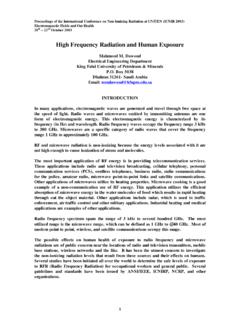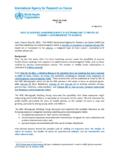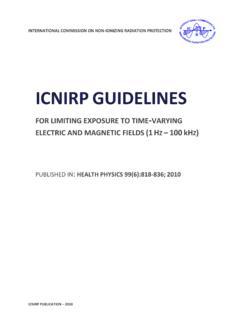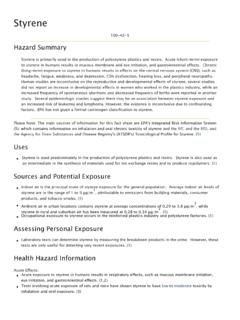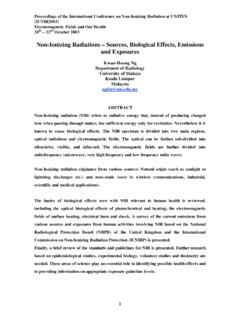Transcription of ITU-T K
1 International Telecommunication Union ITU-T STANDARDIZATION SECTOR OF ITU (05/2012) SERIES K: PROTECTION AGAINST INTERFERENCE Evaluation techniques and working procedures for compliance with exposure limits of network operator personnel to power- frequency electromagnetic fields Recommendation ITU-T Rec. ITU-T (05/2012) i Recommendation ITU-T Evaluation techniques and working procedures for compliance with exposure limits of network operator personnel to power- frequency electromagnetic fields Summary Recommendation ITU-T provides evaluation techniques and guidelines for compliance with safety limits for human exposure to electromagnetic fields (EMFs) of telecommunication network personnel ( , outside plant craft) at power frequencies (DC, 50 Hz and 60 Hz).
2 This Recommendation does not set safety limits; it seeks to provide techniques and procedures for determining the need for any precautions at the work site. This Recommendation includes an electronic attachment containing the EMFACDC program. History Edition RecommendationApproval Study Group ITU-T 2012-05-29 5 ii Rec. ITU-T (05/2012) FOREWORD The International Telecommunication Union (ITU) is the United Nations specialized agency in the field of telecommunications, information and communication technologies (ICTs).
3 The ITU Telecommunication Standardization Sector ( ITU-T ) is a permanent organ of ITU. ITU-T is responsible for studying technical, operating and tariff questions and issuing Recommendations on them with a view to standardizing telecommunications on a worldwide basis. The World Telecommunication Standardization Assembly (WTSA), which meets every four years, establishes the topics for study by the ITU-T study groups which, in turn, produce Recommendations on these topics.
4 The approval of ITU-T Recommendations is covered by the procedure laid down in WTSA Resolution 1. In some areas of information technology which fall within ITU-T 's purview, the necessary standards are prepared on a collaborative basis with ISO and IEC. NOTE In this Recommendation, the expression "Administration" is used for conciseness to indicate both a telecommunication administration and a recognized operating agency. Compliance with this Recommendation is voluntary. However, the Recommendation may contain certain mandatory provisions (to ensure, , interoperability or applicability) and compliance with the Recommendation is achieved when all of these mandatory provisions are met.
5 The words "shall" or some other obligatory language such as "must" and the negative equivalents are used to express requirements. The use of such words does not suggest that compliance with the Recommendation is required of any party. INTELLECTUAL PROPERTY RIGHTS ITU draws attention to the possibility that the practice or implementation of this Recommendation may involve the use of a claimed Intellectual Property Right. ITU takes no position concerning the evidence, validity or applicability of claimed Intellectual Property Rights, whether asserted by ITU members or others outside of the Recommendation development process.
6 As of the date of approval of this Recommendation, ITU had not received notice of intellectual property, protected by patents, which may be required to implement this Recommendation. However, implementers are cautioned that this may not represent the latest information and are therefore strongly urged to consult the TSB patent database at ITU 2012 All rights reserved. No part of this publication may be reproduced, by any means whatsoever, without the prior written permission of ITU.
7 Rec. ITU-T (05/2012) iii Table of Contents Page 1 Scope .. 1 2 1 3 Terms and definitions .. 2 4 Abbreviations and acronyms .. 2 5 General principles .. 3 Field exposure limits .. 3 exposure zones .. 4 Sparkover .. 5 6 Magnetic and electric field calculations .. 5 General procedure .. 5 Magnetic field .. 6 Electric field .. 7 7 Computer program .. 8 8 Examples of calculations .. 8 Simple geometries .. 8 Typical examples of power lines .. 10 9 Work procedures .. 15 Appendix I MAD values for communication workers used in North America.
8 17 Appendix II Description of the program EMFACDC .. 18 20 Electronic attachment: EMFACDC program Rec. ITU-T (05/2012) 1 Recommendation ITU-T Evaluation techniques and working procedures for compliance with exposure limits of network operator personnel to power- frequency electromagnetic fields 1 Scope This Recommendation1 aims to help with compliance of telecommunication network personnel working in vicinity of medium-voltage (MV) and high-voltage (HV) power lines with safety limits for human exposure to electromagnetic fields (EMFs) at power frequencies (DC, 50 Hz and 60 Hz).
9 Also, it aims to provide practical work rules as one of the means of safeguarding network personnel that may need to work in close proximity to the MV and HV power lines. Where local or national laws, standards or guidelines on work safety or exposure limits to EMF exist and provide procedures that are at variance with this Recommendation, the pertinent local or national laws, standards or guidelines shall take precedence over the procedures provided in this Recommendation. This Recommendation does not cover exposure to electromagnetic fields at frequencies other than DC, 50 Hz and 60 Hz.
10 This Recommendation does not cover exposure to touch currents that arise as a result of coupling of electromagnetic fields generated by the power lines to other metallic objects, including telecommunication circuits. [b- ITU-T ] aims to help with compliance of telecommunication installations and mobile handsets or other radiating devices used against the head with safety limits for human exposure to electromagnetic fields (EMFs). [b- ITU-T ] covers safety issues related to people coming in contact with telecommunication circuits exposed to the induction of AC electric power or AC electrified railway lines.

